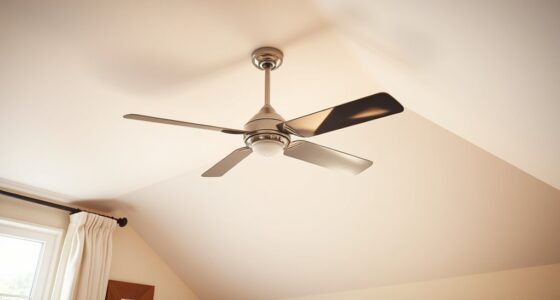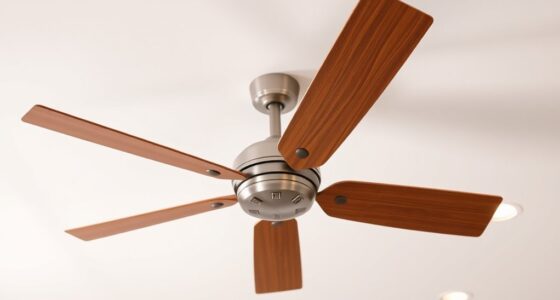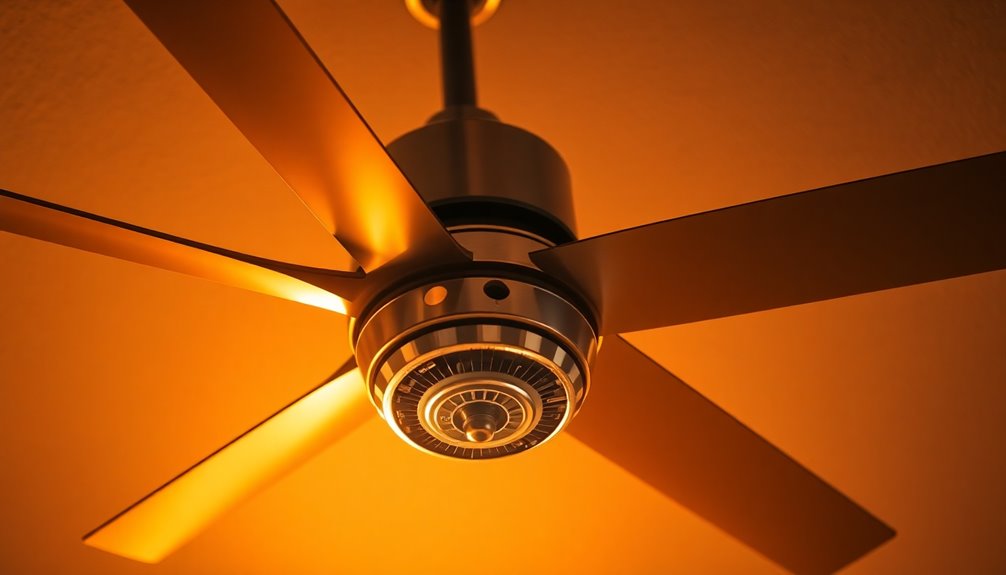To choose the right size ceiling fan for your room, first measure its area. For small rooms (up to 100 sq ft), opt for a fan with a 29-36 inch blade span. In medium spaces (100-175 sq ft), go for 36-42 inches. For larger areas (175-350 sq ft), select a fan between 44-50 inches. Great rooms over 400 sq ft need fans measuring 50-71 inches. Also, factor in your ceiling height and built-in furniture. These details can affect your choice, ensuring ideal airflow and comfort. There's more to know about installation and design for the best fit.
Key Takeaways
- Measure your room size (length x width) to determine appropriate fan size based on square footage.
- For small rooms (up to 100 sq ft), select fans with a blade span of 29-36 inches.
- Choose 36-42 inch fans for medium rooms (100-175 sq ft) for optimal airflow.
- Larger spaces (175-350 sq ft) require fans sized 44-50 inches for efficient air circulation.
- Great rooms (over 400 sq ft) benefit from fans measuring 50-71 inches to enhance comfort.
Understanding Ceiling Fan Sizes

When you're choosing a ceiling fan, understanding its size is key to achieving ideal airflow in your space. Ceiling fan sizes are primarily determined by the blade span, which must match your room's square footage for ideal airflow and comfort.
For small rooms up to 100 square feet, a fan diameter of 29-36 inches is recommended. If you have a medium room (100-175 sq ft), look for fans between 36-42 inches.
For larger rooms (175-350 sq ft), fans sized 44-50 inches will provide the best airflow efficiency. In extra-large spaces over 350 sq ft, you'll need a fan with a diameter of 52 inches or larger.
It's vital to take into account the ceiling height as well, as this affects the fan's performance and comfort level.
Don't forget about CFM ratings, which measure airflow efficiency. Higher CFM ratings indicate better air movement performance, ensuring you stay cool and comfortable.
Choosing the appropriate ceiling fan size can transform your room's atmosphere, making it essential to measure and understand your space before making a purchase.
Measuring Your Room

Measuring your room accurately is vital for selecting the right ceiling fan size. Start by using a tape measure to determine the room size; multiply the length by the width to get the footage of the room. For example, a 12 x 15-foot room equals 180 square feet. Be certain to measure along the longest points of the walls for precise results.
If you have an L-shaped room, divide the space into rectangles, measure each section, and sum the total square footage for accurate calculations.
Additionally, don't forget to measure the height from the floor to the ceiling. This will help guarantee there's adequate clearance between the blades of the fan and any potential obstructions.
Also, consider built-in furniture or features that might affect airflow and placement.
These accurate room measurements are imperative because selecting the wrong fan size can lead to ineffective cooling and discomfort. By taking the time to measure your room correctly, you'll be able to choose a ceiling fan that perfectly fits your space and provides the best airflow, making your living area more comfortable.
Ceiling Fan Size Recommendations

Choosing the right ceiling fan size is essential for maximizing comfort and efficiency in any room. To achieve ideal airflow, you need to match the fan diameter to your room square footage.
For small rooms, up to 100 square feet, fan size recommendations suggest a ceiling fan size of 29-36 inches. If your space falls into the medium room category, between 75-144 square feet, opt for fans ranging from 36 to 42 inches in diameter.
For larger spaces, specifically those between 144-225 square feet, you'll want a fan with a span of 44-50 inches to guarantee effective air circulation.
Finally, great rooms that exceed 400 square feet benefit from ceiling fans that measure 50-71 inches in diameter for adequate airflow coverage.
Selecting the appropriate fan size not only enhances comfort but also improves energy efficiency. An incorrectly sized fan can lead to ineffective cooling or heating, wasting energy and increasing costs.
Factors Affecting Fan Size

Several factors influence the size of the ceiling fan you should select for your space. Primarily, the square footage of the room dictates the ceiling fan size you'll need. For instance, if your room is between 144-225 square feet, a fan between 36 to 50 inches is ideal.
For larger rooms over 400 square feet, choose fans with a blade span of 50 inches or more to guarantee effective air circulation.
The room layout also plays an important role; irregularly shaped rooms may require multiple fans to achieve the desired cooling effect. Additionally, consider heat-generating areas, like kitchens or spaces filled with electronics, which might necessitate larger or extra fans to maintain comfort levels.
Ceiling height is another significant factor. If you have higher ceilings, you might require longer downrods to guarantee the best airflow. Conversely, low ceilings call for flush mount fans to avoid any safety hazards and to maximize your space.
Ceiling Height Considerations

When considering ceiling height, it's crucial to verify your ceiling fan is installed at a safe and effective height for maximum airflow. A ceiling fan should be at least 7 feet above the floor to guarantee safety and enhance air circulation.
If your ceiling height is lower than 8 feet, flush mount fans are a great choice. They provide sufficient clearance without compromising airflow quality.
Here are some key considerations for fan installation based on ceiling height:
- Minimum clearance: Maintain 8-10 inches from the ceiling to the blades to improve airflow.
- Downrod length: For ceilings higher than 9 feet, a downrod is often needed. Generally, a 12-inch downrod works well for a 10-foot ceiling.
- Blade height: Aim for the fan blades to be around 8 feet from the floor for perfect air circulation.
Airflow and Efficiency

Understanding ceiling height and fan installation sets the stage for enhancing airflow and efficiency in your space. To achieve this, you need to evaluate the ceiling fan size that best suits your room dimensions.
For example, a 52-inch fan can effectively circulate air in rooms up to 400 square feet, while larger areas might require fans exceeding 60 inches.
Airflow is measured in cubic feet per minute (CFM), and higher CFM ratings indicate better air circulation and performance. Proper fan sizing can help reduce your need for air conditioning by cooling rooms by 6-8 degrees, leading to significant energy savings.
The blade pitch of your fan also plays an important role in airflow. Fans with a higher blade pitch tend to move air more effectively at lower speeds, which enhances comfort without consuming excessive energy.
Selecting the Right Mounting Type

When you're choosing a ceiling fan, selecting the right mounting type is essential for both style and functionality.
If your ceiling is under 8 feet, a flush mount fan saves space while a downrod mount is perfect for ceilings 9 feet or higher.
Consider your ceiling height and make sure your fan is at least 7 feet above the floor for safety and ideal airflow.
Flush Mount Advantages
Choosing the right mounting type for your ceiling fan can make a significant difference in both functionality and style. If you have low ceilings, flush mount ceiling fans are an excellent choice. They require only a clearance of 6-10 inches from the ceiling, making them perfect for spaces with ceilings under 8 feet. This design enhances safety and guarantees effective airflow without obstruction.
Here are a few advantages of flush mount ceiling fans:
- They maintain visual balance in small rooms (up to 100 sq ft), avoiding the disproportionate look of larger downrod-mounted fans.
- Often preassembled, they simplify the installation process, saving you both time and installation costs.
- They deliver similar airflow performance as traditional mounts, assuring your comfort without the clutter of additional downrods.
Downrod Mount Requirements
For rooms with higher ceilings, downrod mounting is the preferred option to guarantee your ceiling fan operates effectively and safely. This type of mount is vital for ceilings exceeding 9 feet, as it helps position the fan at an ideal height of about 8 feet from the floor.
For a 10-foot ceiling, a 12-inch downrod is generally recommended to maintain adequate clearance between the fan blades and the ceiling.
When selecting a downrod, you must consider the fan housing height, which typically ranges from 8 to 12 inches. This measurement will help you calculate the total drop required for effective air circulation.
Confirm the downrod you choose is compatible with your fan model and is sturdy enough to support its weight and operation.
It's also important to reference the manufacturer specifications for recommended downrod lengths based on your ceiling height. Following these guidelines can prevent installation issues, making sure that your fan functions efficiently while providing the desired airflow in your space.
Ceiling Height Considerations
Selecting the right mounting type for your ceiling fan hinges on the height of your ceiling. For ceilings under 8 feet, a flush mount ceiling fan is your best bet. It guarantees adequate clearance for airflow, keeping the fan blades close to the ceiling while maintaining effective air circulation.
If your ceiling height ranges from 9 to 10 feet, you'll need a downrod of at least 12 inches to position the blades about 8 feet from the floor, essential for ideal fan performance.
When considering angled mounting, remember to adjust the downrod length based on the slope of your ceiling to guarantee safety and efficiency.
Here are some key points to keep in mind:
- Measure ceiling height before fan installation to pick the right mounting type.
- Standard ceiling fans require 12 to 14 inches of clearance for airflow, while flush mount fans need about 6 to 10 inches.
- Always prioritize air circulation to guarantee comfort in your space.
Importance of Blade Design

When it comes to ceiling fans, blade design plays a significant role in enhancing the overall aesthetic of your space. While you might be drawn to a fan's visual appeal, it's vital to take into account how blade design impacts functionality. The pitch of the blades is critical for airflow efficiency; steeper pitches generally enhance air movement, making your fan more effective for cooling and heating.
Traditional ceiling fans typically feature 4 to 5 blades, achieving a good balance between air circulation performance and noise levels. Although the shape and material of the blades can contribute to the room decor, remember that the fan's motor type and blade pitch are more significant factors in determining how well your fan performs.
When selecting a ceiling fan, it's important to prioritize both aesthetic appeal and functionality. A fan with the right blade design not only complements your decor but also guarantees ideal airflow throughout the room.
Calculating Downrod Length

When calculating the downrod length for your ceiling fan, start by measuring your ceiling height and subtracting the desired fan height, which should ideally be around 8 feet from the floor.
If your ceiling exceeds 9 feet, you'll need a downrod to guarantee proper airflow and clearance.
Remember to factor in the fan's housing height to achieve the best setup for comfort and safety.
Downrod Measurement Guidelines
To guarantee your ceiling fan operates effectively, calculating the appropriate downrod length is essential.
Start by measuring your ceiling height and subtracting the desired fan height, ideally around 8 feet from the floor to the blades. For ceilings higher than 9 feet, using a downrod becomes necessary to assure ideal air circulation.
Here are some key points to reflect on:
- A common guideline is to use a 12-inch downrod for a 10-foot ceiling, allowing the fan to sit at the recommended height.
- Don't forget that fan housings typically measure between 8 to 12 inches tall, which needs to be factored into your calculations.
- Reference charts are available to help match ceiling heights with appropriate downrod lengths, making your installation easier.
Optimal Fan Height
Determining the ideal fan height is vital for ensuring effective air circulation in your room. Ideally, you want the fan blades to be about 8 feet above the floor for best performance. To achieve this, you need to calculate the necessary downrod length based on your ceiling height.
Start by measuring your ceiling height and then subtract the height of the fan housing, which typically ranges from 8 to 12 inches. This calculation helps you determine how long your downrod should be. If your ceiling height exceeds 9 feet, a downrod is necessary to maintain proper clearance and airflow. For instance, a 12-inch downrod works well for a 10-foot ceiling.
It's important to maintain a minimum clearance of 12-14 inches between the fan blades and the ceiling to enhance air circulation.
Using downrod length charts can simplify the process, guiding you in selecting the right size for your ceiling height. By ensuring the fan is mounted at the best height, you'll maximize both air movement and comfort in your space, allowing for a more enjoyable atmosphere year-round.
Installation Tips and Best Practices

Installing a ceiling fan correctly is essential for guaranteeing ideal air circulation and safety in your home. To achieve this, follow these installation tips tailored to your ceiling fan size and type. For ceilings under 8 feet, use a flush mount to maintain proper clearance, while a downrod mount works best for higher ceilings.
Here are a few best practices to keep in mind:
- Verify the fan blades are positioned approximately 8 feet above the floor for maximum air circulation.
- Check that the electrical box is sturdy enough to support the fan's weight, especially for larger models that may require professional installation.
- Regularly maintain the fan by cleaning the blades and checking for loose screws or wear on the motor.
Frequently Asked Questions
Is a 42 Inch Fan Big Enough for a Bedroom?
A 42-inch fan's often just right for most bedrooms, especially those ranging from 100 to 200 square feet.
You'll find it provides adequate airflow for comfort and cooling. If your bedroom's around 144 square feet or less, it should work perfectly.
Just make sure to mount it at least 8 feet high for the best efficiency.
If your room's larger, you might want to contemplate a bigger fan for enhanced airflow.
Is a 60 Inch Ceiling Fan Too Big for a Bedroom?
A 60-inch ceiling fan can feel like a powerful whirlwind in a petite paradise.
If your bedroom's spacious, it might circulate sweet, soothing breezes beautifully. However, if your room's more modest, that fan could create a chaotic wind tunnel, leaving you chilly and uncomfortable.
You'll want to contemplate your space's dimensions and layout carefully. If it's under 400 square feet, you might want to opt for a smaller size for ideal comfort.
What Size Room for a 54 Inch Ceiling Fan?
When you're choosing a ceiling fan, a 54-inch model's ideal for rooms between 225 and 400 square feet.
It provides effective airflow without being overpowering, making it great for spaces like living rooms or master bedrooms.
If your room's larger than 400 square feet, you might need a bigger fan for peak cooling.
Always consider the fan's CFM rating, ceiling height, and room layout to maximize efficiency and comfort.
Is a 52 Inch Fan Too Big for a 12X12 Room?
A 52-inch fan is likely too big for your 12×12 room.
It can create a wind tunnel effect that makes the space feel uncomfortable, and it might overwhelm the room's aesthetics.
You'll want to take into account a fan in the 36 to 42-inch range for better airflow and a balanced look.
A properly sized fan guarantees efficient cooling and energy use, enhancing your comfort without compromising your room's design.
Conclusion
Choosing the right ceiling fan isn't just a decision; it's a game changer for your room! Imagine sweltering under the summer sun, only to be rescued by the perfect breeze from your fan—it's like having your own personal wind machine! By considering size, height, and design, you can transform your space into a sanctuary of comfort. Don't settle for anything less than perfection; your ultimate relaxation experience is just a ceiling fan away!









